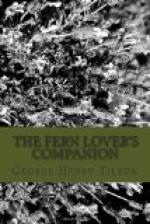These varieties are represented in the Gray Herbarium.
(2) THE LOWLAND LADY FERN
ATHYRIUM ASPLENIOIDES
Rootstocks creeping, not densely covered with the persistent bases of the fronds. Stipes about as long as the blade. Scales of the stipe very few, seldom persistent, rarely over 3-16 of an inch long. Fronds narrowly deltoid, lanceolate, widest near the base, the second pair of pinnae commonly longest. Indusia ciliate, the cilia (hairs) ending in glands. Spores dark, netted or wrinkled.
[Illustration: Lowland Lady Fern. ATHYRIUM ASPLENIOIDES (From the Gray Herbarium)]
The following two forms are named by Butters:
F. TYPICUM. The usual form frequent in eastern
Massachusetts, Rhode Island,
Connecticut, New York, Pennsylvania, North Carolina,
Ohio, and Missouri.
F. SUBTRIPINNATUM. An unusually large and rare form with triangular, lanceolate, and pinnatifid pinnules, having blunt, oblong segments. Wet situations in half shade. Massachusetts, West Virginia, and Virginia.
Our lowland or southern lady fern flourishes in the southern states, comes up the Atlantic Coast until it meets the upland or northern species in Pennsylvania and southern New England, and their identification can hardly fail to awaken in the student a keen interest.
Our American botanists are inclined to think that the real Athyrium filix-femina is not to be found in the northeastern United States, but is rather a western species, with its habitat in California and the Rocky Mountain region and identical with Athyrium cyclosorum.
But whatever changes may occur in the scientific name of the old Athyrium filix-femina, the name lady fern will not change, but everywhere within our limits it will hold its own as a familiar term.
Underwood, writing of the lady fern under the genus Asplenium, mentions the form “exile, small, starved specimens growing in very dry situations and often fruiting when only a few inches high.” He also mentions Eaton’s “angustum,” and alludes to the “Remaining sixty-three varieties equally unimportant that have been described of this species.”
The lady fern is common in moist woods, by walls and roadsides, and at its best is a truly handsome species, although, like Mrs. Parsons, we have noticed that in the late summer it loses much of its delicacy. “Many of its forms become disfigured and present a rather blotched and coarse appearance.” The lady fern has inspired several poems, which have been quoted more or less fully in the fern books. The following lines are from the pen of Calder Campbell:
“But not by burne in wood or dale
Grows anything so fair
As the palmy crest of emerald pale
Of the lady fern when the sunbeams turn
To gold her delicate hair.”
Referring, perhaps, to the fair colors of the unfolding crosiers revealing stipes of a clear wine color in striking contrast with the delicate green of the foliage.




